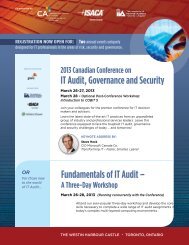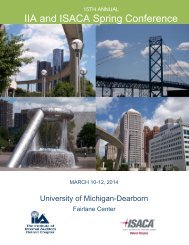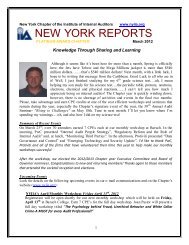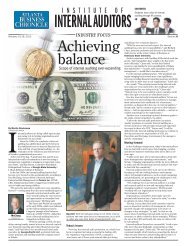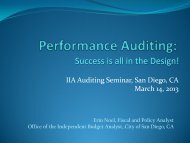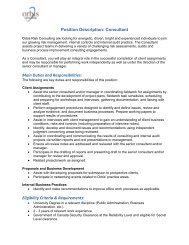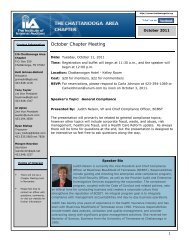Sampling Techniques That Work
Sampling Techniques That Work
Sampling Techniques That Work
Create successful ePaper yourself
Turn your PDF publications into a flip-book with our unique Google optimized e-Paper software.
<strong>Sampling</strong><br />
<strong>Techniques</strong> <strong>That</strong> <strong>Work</strong><br />
for Public Sector Auditors<br />
2013<br />
IIA, San Diego March 14, 2013<br />
Lois W. Sayrs, Ph.D.
Session Objectives<br />
Understand basics of probability and nonprobability<br />
sampling<br />
Become aware of the range of samples that<br />
work well for public sector auditing<br />
To know how, when and why to use various<br />
sampling techniques on audits<br />
To review a sampling case study and draw<br />
implications to public sector audits
Purpose of <strong>Sampling</strong> in<br />
Governmental Auditing<br />
Application of an audit procedure to<br />
less than 100% of items within a class<br />
or account balance for the purpose of<br />
evaluating some characteristics of that<br />
class or balance
Comparing Financial and<br />
Performance <strong>Sampling</strong><br />
<strong>Techniques</strong><br />
<br />
Financial<br />
• To provide assurance that the financial statements<br />
are not materially misstated<br />
• AICPA Audit Guide, Audit <strong>Sampling</strong>, 2012<br />
• Performance materiality<br />
• Tolerable misstatment<br />
<br />
Performance<br />
• To support conclusions of findings made as a result of<br />
the audit.<br />
• Risk of drawing false conclusion<br />
• No direct guidance or clear audit standards
Performance Materiality<br />
<br />
Performance materiality means<br />
• the amount or amounts set by the auditor at less than<br />
materiality for the financial statements as a whole to reduce<br />
to an appropriately low level the probability that the<br />
aggregate of uncorrected and undetected misstatements<br />
exceeds materiality for the financial statements as a whole.<br />
• If applicable, performance materiality also refers to the<br />
amount or amounts set by the auditor at less than the<br />
materiality level or levels for particular classes of<br />
transactions, account balances, or disclosures.<br />
• Performance materiality is similar to tolerable misstatement;<br />
however, tolerable misstatement is associated with<br />
sampling only. (AU 320.09)
Examples of <strong>Sampling</strong> from<br />
Public Sector Audits<br />
Validate data bases, reports<br />
Compliance tests<br />
Substantive tests on reasonableness<br />
of balances<br />
Establish rates of occurrence in the<br />
population<br />
Establish total dollars in the<br />
population
Adapting <strong>Sampling</strong> Theory<br />
for Auditing<br />
Does not have to be statistical<br />
Can accept risk at fairly high levels<br />
Can accept likelihood of error<br />
Confidence levels adjusted for<br />
variance and unknown populations<br />
Sample sizes are smaller<br />
Statements meet performance<br />
materiality
Probability Theory/<strong>Sampling</strong><br />
Distributions<br />
Why small samples work<br />
Example of sampling distribution
<strong>Sampling</strong> <strong>Techniques</strong> that<br />
work:<br />
1. Ask what kind of sample do I<br />
need?<br />
• Probability: when generalization is required<br />
• Estimate total dollars in population<br />
• Estimate total errors<br />
• Non-probability: when generalization is not<br />
required<br />
• Validation<br />
• Compliance
2. Know the unit of analysis<br />
<strong>Sampling</strong> units-what are you<br />
sampling: item, dollar, event,<br />
individual, case, team, day, hour,<br />
complaint, etc.?<br />
What is the question you are asking<br />
and what unit will best answer it?
3. Know the population<br />
Estimate population if exact<br />
population is not available<br />
Risk and confidence=prior knowledge<br />
• Best practice is for the auditor to consider all special knowledge about the<br />
items constituting the class prior to designing the sample AICPA 2.31.<br />
Estimate completeness<br />
• 3 steps (external; internal-2 way)
4. Determine what type of<br />
sample will work best<br />
Representativeness<br />
Randomness<br />
Risk of making an error-drawing the wrong<br />
conclusion<br />
Probability or non-probability
Probability <strong>Sampling</strong><br />
Types of Probability Samples<br />
A. Attribute sampling<br />
B. Acceptance sampling<br />
C. Discovery sampling<br />
D. Variable sampling<br />
E. <strong>Work</strong> sampling<br />
• Random or predetermined<br />
• Extended cycle analysis<br />
• Fractioned professional estimates
A/B: Attributes/Acceptance<br />
<strong>Sampling</strong><br />
Attributes and Acceptance<br />
• Calculate maximum number of<br />
acceptable errors based on probability<br />
tables.<br />
• Short-cut: “stop-n-go”<br />
• Examples: files; data fields;<br />
compliance tests; lots
C:Discovery <strong>Sampling</strong><br />
Discovery <strong>Sampling</strong><br />
• used to explore a population<br />
• Small samples<br />
• Big risk, low confidence<br />
• Perfect for preliminary survey<br />
• Poor for fraud test<br />
• Must be added to during fieldwork
D:Variable <strong>Sampling</strong><br />
Variable <strong>Sampling</strong><br />
• Used for substantive audit tests<br />
• Establishes valid estimates<br />
• Examples: dollars lost to inefficiencies; cars<br />
left unutilized; overpayments to school<br />
districts; wait time; consumer spending at the<br />
state fair<br />
• Requires big sample and well-conceived<br />
sampling strategy to minimize bias<br />
• Case review: Arizona MVD wait time
E:<strong>Work</strong> <strong>Sampling</strong><br />
<br />
<strong>Work</strong> <strong>Sampling</strong><br />
• Random evaluation of time periods to assess<br />
compliance with work requirements or standards<br />
(efficiencies); assess delays<br />
• Predetermined evaluation of time periods to help set<br />
standards, e.g. peak times<br />
• Extended cycle analysis-sample all or part of the life<br />
cycle of a process through controlled reporting by<br />
professionals; uses time logs or ladders<br />
• Fractioned professional estimates: sampling various<br />
professionals on how they do a part or fraction of the<br />
process and relying on their estimates of how long it<br />
takes<br />
• Example: Arizona wait times for authorizing<br />
unemployment insurance via phone-combination<br />
method (random, predetermined, fractioned)
Common Errors in<br />
Attribute/Variable <strong>Sampling</strong><br />
Sample too small<br />
Sample biased<br />
Generalize on the wrong basis
5. “Design on a dime”<br />
Sample should optimize budget and<br />
ability to conclude so select carefully:<br />
A. Random<br />
B. Systematic<br />
C. Stratified<br />
D. Cluster<br />
E. Multi-stage<br />
F. PPS<br />
G. Combinations
<strong>Sampling</strong> Designs<br />
A. Random-uses a random number<br />
generator, a random start<br />
B. Systematic-uses a random start<br />
when data are ordered. Sample<br />
every “nth” item. Keep cycling<br />
through the data until you complete<br />
sample. Can be done with a<br />
computer for electronic data or a<br />
ruler for hard files.
<strong>Sampling</strong> Designs<br />
C. Stratified-uses “cuts”, “layers” or<br />
“strata” to minimize variation (and<br />
risk) in the sample, e.g. school<br />
district size<br />
D. Cluster-exploits data that naturally<br />
occurs in a clustered form such as<br />
school districts (district, school,<br />
classroom)
<strong>Sampling</strong> Designs<br />
E. Multistage- samples at various<br />
stages in the process, e.g. contract<br />
bidding and contractor selection<br />
F. PPS –probability proportionate to<br />
size(also known as dollar unit<br />
sampling)-break each transaction<br />
into single dollar units and sample<br />
over the dollar units to maximize<br />
likelihood of capturing large dollar<br />
transactions.
<strong>Sampling</strong> Designs<br />
G. Combinations-effective joining of two<br />
or more sample types to minimize<br />
risk and variation, e.g. combine<br />
school district strata–sample over<br />
small medium and large school<br />
districts, by type (unified, elementary,<br />
union, high school) and clusters-by<br />
school, classroom and teacher within<br />
a district)
Sample Designs: Helpful<br />
Hints<br />
When electronic data is not available:<br />
bring a ruler<br />
When probability sampling is required:<br />
plan on assigning enough audit<br />
budget to know your population<br />
Let risk be your guide
6. Determine the sample size:<br />
key steps<br />
Set risk and sample precision<br />
Set Confidence level<br />
Evaluate Variance<br />
Keep it simple
7. Consider Non-Probability<br />
<strong>Sampling</strong><br />
A. Risk-based<br />
B. Convenience<br />
C. Judgmental<br />
D. Snowball<br />
E. Quota
Non-Probability Samples<br />
A. Risk-based/materiality based<br />
• Uses highest risk items such as worst<br />
offenders; most frequent users<br />
B. Convenience<br />
• Uses what is convenient such as closest<br />
behavioral health centers or schools<br />
C. Snowball<br />
• Uses one item to access another such as<br />
using a school district employee to sample a<br />
third party
Non-Probability Samples<br />
continued<br />
D. Quota<br />
• Uses a pre-specified amount and<br />
stops such as open versus closed<br />
cases<br />
E. Judgmental<br />
• Uses auditor judgment to select<br />
sample such as “Western States”;<br />
simply requires thought and adequate<br />
documentation.
8. Learn from experience<br />
Ask people who know<br />
Be creative<br />
Be confident
Capstone exercise<br />
Small group exercise-911 calls<br />
response time<br />
Develop at least two sampling<br />
strategies<br />
Critique strategies<br />
Select one<br />
Share final sampling decision with<br />
class
Finally…<br />
Case Study<br />
Troubleshooting your own audit work
Thank you!<br />
Contact information:<br />
Lsayrs@azauditor.gov<br />
Linked-in groups<br />
• AGA<br />
• ALGA<br />
• IIA<br />
• ICPA-International Center for<br />
Performance Auditors<br />
• NCSL<br />
• NASACT



